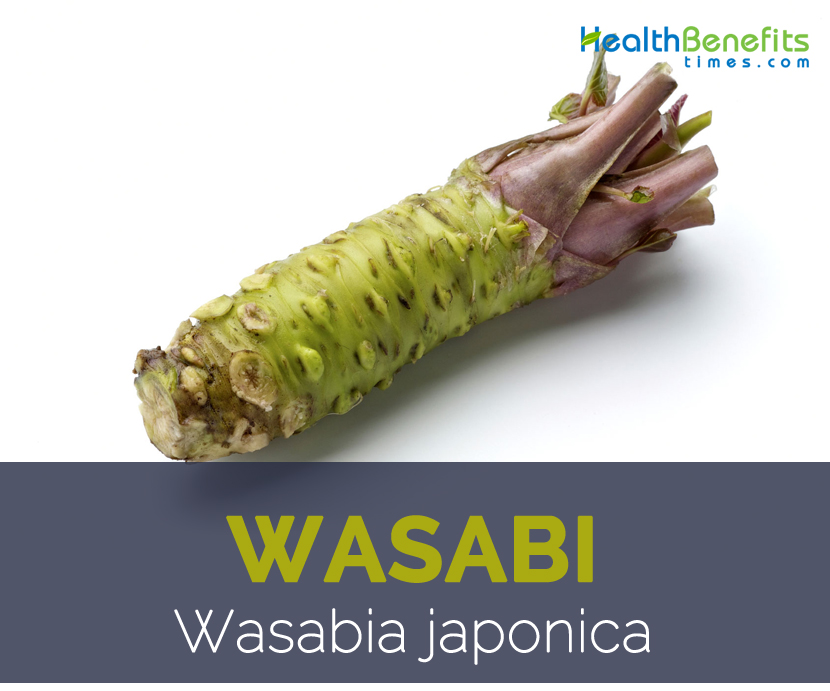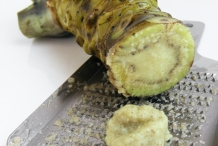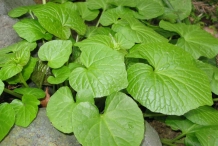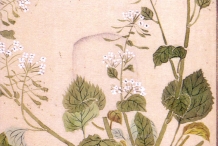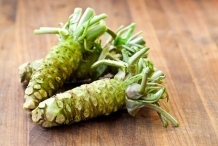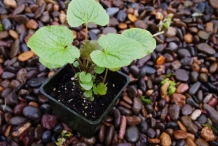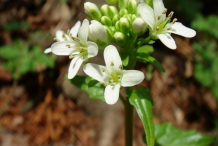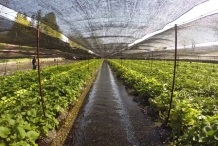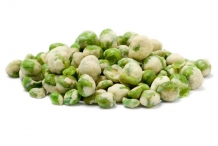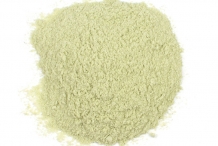Plant
Wasabi is a small herb growing about 20–75 cm high. It is found growing in a humid and damp, temperate environment and prefers loose, very organic-rich, and moist to wet soil. It has firm, cylindrical roots and erect or decumbent stem that are simple, fleshy, 3 cm in diameter. Basal leaves are rosulate; petiole usually 10–20 cm long and dilated at the base. The leaf blade is cordate or reniform, commonly 6–20 cm wide by 6–18 cm long base cordate, margin dentate, denticulate, shallowly crenate, repand or subentire, apex rounded or obtuse. Middle cauline leaves with petioles 1–6 cm; leaf blade broadly ovate to ovate- cordate, 1.5–6 × 2–6 cm, palmately veined, base and margin as in basal leaves, apex acute. Flowers are white, bracteate, arranged on racemes, with ascending sepal, cruciform and obovate petals, perfect septum, elongate styles and simple stigma. Fruit is linear, 1–2 cm × 1.5–2 mm, terete, torulose and 6-8 seeds that are oblong, plump, 2–3 × 1–1.5 mm. Rhizomes are the most preferred plant part of wasabi. Most plants have one or two main rhizomes. Whole fresh plants weigh up to 3.4 kg.
Root
Wasabi is one of the rarest and most difficult vegetables to grow in the world. Almost all parts its leaves, flowers and petioles are edible, rhizome is considered valuable and delightful due to its health benefiting nutrients. It is traditionally used as an herb and flavoring agent for condiments and in various dishes. Wasabi plant has a distinctive thickened stem (or rhizome) which is firm, cylindrical, about 4 to 8 inches in length and about 1.5 to 2 inches in diameter and is green in color. It has a pale, lime green flesh that is commonly used in sushi and sashimi. They have hot or spicy flavor and strong, spicy taste that are used in various dishes. Wasabi adds a distinctive flavor, heat and greenish color to foods and, therefore, it is a highly appreciated plant in Japanese cuisine. Wasabi is described as having ‘a sharp hot taste with pungent smell’ but the heat component in wasabi is dissimilar from chilies, and the hotness rapidly dissipates in the mouth leaving an extremely pleasant mild vegetable taste, with no burning sensation at all. Because of its unique taste, higher nutritional values and health benefits wasabi is grown throughout the world.
History
Wasabi is considered to have originated from Japan, Korea, Russia (Far East) and North China. It is not known when wasabi was first brought into cultivation however Japanese ancient records show that wasabi, known originally as wild ginger, was introduced as a medicinal plant by Sukahito Fukae. The first Japanese medical encyclopedia called “Honzowamyo” was published in A.D. 918 and it states that “wild ginger” (wasabi) had been grown in Japan for at least a thousand years. Presently Shimane region is the largest area of wasabi production and breeding research in Japan. Wasabi is now grown in many countries around the world including New Zealand, Brazil, Taiwan, Korea, Canada, Israel, near Vancouver, Thailand, Columbia and Oregon, USA. Wasabi is grown in New Zealand for export of frozen rhizomes to Japan and it is also processed into a number of different wasabi flavored food products.
Nutritional Value
Apart from their unique look and strong, spicy taste, wasabi is a good source of nutrients, vitamins and minerals. Consuming 100 gram of Wasabi offers 54.5 mg of Vitamin C, 0.356 mg of Vitamin B6, 10.1 g of Total dietary Fiber, 30.6 g of Carbohydrate, 0.201 mg of Copper, 0.508 mg of Manganese, 90 mg of Magnesium and 2.11 mg of Zinc.
Health benefits of Wasabi
There are numerous myths regarding wasabi. As an example, wasabi is simply not accountable for cleaning up your sinuses as well as opening up your nasal pathways; in reality, it really does the opposite. Still, there are some reasons for wasabi which are very beneficial as well as which might come as a surprise. Continue reading for some of these health advantages.
1. Cancer Prevention
Regular use of wasabi to the diet can avoid certain types of cancer. The most prominent and beneficial nutrients found are the isothiocyanates. These form from glucosinolates after the plant is collected or cut. The various isothiocyanate antioxidants are beneficial in removing free radicals from the body’s systems. Researches have shown that one form of isothiocyanate in wasabi, 6-MITC, has been obviously shown to prevent the development of leukemia and stomach cancer cells. It in fact encourages apoptosis (cell death) within 24 hours of consumption. The use of wasabi may avoid the growth of tumors, even at a pre-clinical or pre-treatment size. The most attractive thing about this type of treatment is that isothiocyanates appear to kill cancer cells without damaging the healthy, surrounding cells.(1), (2)
2. Promotes Hair Health
Wasabi consists of vitamin C which is one of the most effective nutrients to grow and strengthen hair. To give your locks a vital dose of vitamin C, include vitamin c rich foods like wasabi in your regular diet since wasabi consists of 54.5 mg of vitamin C which is 60.56% of the daily recommended value. So to promote your hair’s health include wasabi in your day to day diet.
3. Kills Harmful Food-Borne Bacteria
Research has shown that wasabi offers a powerful punch when it comes to protection against some bacteria. Research conducted at Chiba University’s Laboratory of Plant Cell Technology in Japan notes that using wasabi on potatoes made them more disease-resistant. Another research published in the Journal of Applied Microbiology shows the same when applied to tomatoes. Incorporation of selected wasabi culture into potted soil considerably reduced bacterial infection on tomatoes, and treating the tomatoes produced outstanding control efficacies against M. incognita with the fresh wasabi residue.(3), (4)
4. Cardiovascular Health
Regular consumption of wasabi is extremely beneficial for preventing cardiovascular problems. It has anti-hypercholesterolemic features that help in lowering high cholesterol levels in the human body, strokes and heart attacks. Apart from that isothiocyanates in wasabi have inhibitory effects on platelet aggregation. Platelet aggregation is mainly the grouping together or clumping of blood platelets into a thrombus, or blood clot. These clots are the main reasons of strokes and other cardiovascular crises. By breaking down and inhibiting the formation of these clots throughout the body, it efficiently reduces risks for heart disease and stroke!
5. Depression
Vitamin B6 found in wasabi helps body to make serotonin, a chemical that influences mood. Low levels of serotonin are allied with depression and some antidepressant medications work by raising levels of serotonin. Some researchers think that vitamin B6 might help reduce symptoms of depression. So include vitamin B6 rich food like wasabi to remain safe from depression.
6. Respiratory Conditions
Wasabi can prevent you from certain respiratory tract pathogens. The gaseous component of wasabi, that causes a powerful reaction in the nasal passages and sinuses, is actually the gaseous release of allyl isothiocyanate, which can vigorously prevent the proliferation of respiratory tract pathogens like those that cause influenza and pneumonia. The smell and the sensation in your nose after consuming it may be strong, but it can do a lot of good for your health and well-being.(5)
7. Prevents Tooth Decay
Due to its ability to eliminate bacteria, it’s a natural antimicrobial agent often used with raw fish. This is mainly because of the isothiocyanate vapors wasabi produces. These vapors help discourage the growth of yeast, mold and bacteria. Interestingly, it also helps prevent tooth decay by destroying the bacteria that may cause it.(6), (7)
8. Arthritis and Inflammation
Wasabi, is shown to reduce cases of joint swelling, inflammation, and can even soothe the effects of arthritis. Isothiocyanate compounds present in wasabi help to reduce the inflammation of joints, ligaments, and muscles that may lead to arthritis and joint pain. Research recommends that wasabi helps in maintaining bone integrity in humans and can help in decreasing the risk of osteoporosis. Similarly isothiocyanates reduce platelet aggregation to protect from heart disease; they can also reduce the aggregation at weak points on the body that result in pain or discomfort. Add some wasabi to your diet and feel healthier and younger!(8)
9. Helps heal wounds faster
Known for its immense anti-bacterial, an anti-viral and anti-inflammatory property, copper is a wonderful tool for healing wounds rapidly. Apart from that, copper is also known to support your immune system and aid in the production of new cells. But its healing properties don’t stop with helping the body externally; copper is also known to help wounds within the body, especially the stomach.
10. Antibacterial Effects
Wasabi have been shown to fight off bacterial infections! In a recent study of the antibacterial properties of various foods and vegetables, wasabi graded as the most effective antibacterial food against E. coli and Staphylococcus aureus (Staph infections). This means food poisoning and other disastrous conditions can be prohibited by maintaining levels of isothiocyanates in the diet by regular consumption of wasabi. Again, the isothiocyanates are proven to be the vital component that neutralized these deadly bacteria within the body. Some companies have started to include trace elements of wasabi extract in their antibacterial creams and gels to boost their strength and effectiveness!(9), (10)
How to Eat
- Rhizome plus the base part of the stem is freshly grated to prepare wasabi – a pungent, hot sweetish, relish that is a highly prized culinary ingredient spice and condiment.
- Traditionally, wasabi has been served with raw fish dishes in Japan, because the active constituents within the plant may have been an antidote for food poisoning by killing microbes.
- Wasabi is crucial for preparing nigiri-zushi, a special kind of small kneaded ball combining vinegared rice and fish slices.
- Outside of Japan, this spice is only available dried in the form of a pale green powder or in form of a green paste.
- Wasabi goes well with dishes that contain different kinds of raw fish.
- Together with a sprinkle of soy sauce, wasabi paste and water go also very well with tempura, deep-fried battered vegetables like Perilla–Giso and in dishes such as sushimi and soba.
- Wasabi imparts a unique flavor and heat to foods and can be served as a spice or an herb in a dish or as a condiment on the side.
- A special pickle is also made from fresh-sliced wasabi rhizomes which are cured in the residue left from fermenting rice wine.
- Leaves, flowers, leafstalks and freshly sliced rhizome are soaked in salt water and then mixed with sake lees to make a popular Japanese pickle called wasabi-zuke.
- Leaves can be dried and used for flavor in foods like cheese, salad dressings and crackers.
- Wasabi wine and a higher alcohol content wasabi liqueur are being sold in some specialty stores.
- Leaves can be eaten raw in salads, pickled or even fried into chips.
- Grated wasabi is mixed with other ingredients like soya sauce and vinegar to prepare a dip for use with raw fish or other dishes, according to individuals’ choice.
- Tofu (soybean curd) is frequently decorated with grated wasabi.
Other Traditional uses and benefits of Wasabi
- Wasabi are a natural herb for deodorization and detoxification purposes, as well as for its antimicrobial activity.
- Wasabi rhizome is a pungent warming herb that is used internally as an antidote to fish poison.
Types of wasabi
Typically the most popular variety of Wasabi is recognized as Daruma. Nearly all Wasabi cultivated by Pacific Coast Wasabi is definitely the Daruma variety, however the Mazuma variety may also be developed, for even though it is nearly less appealing in look, it’s got much more heat compared to Daruma.
1. Wasabi Daruma
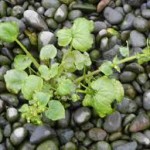 Lively, green paste produced from the grated rhizomes of Wasabi is probably the most extremely tasting condiments of Asia. The first heat is felt instantly in the nasal passage, that rapidly decreases in intensity. Even though Wasabi favors a cool as well as shaded place, in damp soils, the variety Daruma will certainly endure warmer circumstances than most. Regrettably, most wasabi obtainable in Australia is made of horseradish as well as food coloring, lacking the fantastic power of the this unique plant.
Lively, green paste produced from the grated rhizomes of Wasabi is probably the most extremely tasting condiments of Asia. The first heat is felt instantly in the nasal passage, that rapidly decreases in intensity. Even though Wasabi favors a cool as well as shaded place, in damp soils, the variety Daruma will certainly endure warmer circumstances than most. Regrettably, most wasabi obtainable in Australia is made of horseradish as well as food coloring, lacking the fantastic power of the this unique plant.
2. Wasabi Mazuma
 Mazuma variety may also be created, for even though it is almost much less appealing in look, it’s got much more heat compared to the Daruma.
Mazuma variety may also be created, for even though it is almost much less appealing in look, it’s got much more heat compared to the Daruma.
Selecting Wasabi
Wasabi powders as well as pastes obtainable in the majority of US supermarkets as well as sushi restaurants usually are not real wasabi at all, or even include reduce quality wasabi stems. Common ingredients consist of horseradish powder (dried and ground regular horseradish), mustard powder, cornstarch, as well as synthetic coloring. Simply because wasabi plants are unusual as well as specific within their needs, real wasabi is more expensive compared to horseradish and also is considered an uncommon treat. When choosing fresh wasabi for grating, select fresh, cool, unshriveled roots. When choosing fresh leaves of the wasabi plant make use of the exact same recommendations you would employ for choosing salad greens; no sogginess or even wilt, uniform color, and so on.
Storage
Cover wasabi roots within moist towels and also chill if not being utilized. Wash them in cold water each few days as well as cut at the appropriate time to eliminate ruined spots. The shelf life of refrigerated wasabi roots is around Thirty days. Wasabi leaves ought to be kept in the refrigerator as well as utilized as quickly as possible.
Preparation
Wasabi adds a distinctive taste as well as zest to foods, offered like a spice or perhaps an herb in the dish, or even like a condiment on the side.
The root is very first peeled using a knife. The taste of wasabi is unveiled when it’s finely ground in a thicker green paste. Conventional Japanese chefs realized this by scrubbing the root on the sharkskin, however, you can do it utilizing a circular motion around the backside of the metal grater in which the spikes are tiny. Pile the grated wasabi in a ball as well as let stand at room temperature for 5 to 10 minutes allowing the flavor and heat to build up. The taste will dissolve soon after four hours or more.
- Serve along with soy sauce to come with sushi or even sashimi (raw fish dishes).
- Add to noodle soups.
- Use like a condiment for grilled meats as well as vegetables.
- Add wasabi to salad dressings, marinades, as well as dips.
- Toss along with roasted veggies.
Culinary Uses
- A staple condiment in Japan, wasabi is offered along with sushi, sashimi, soba noodles and several other conventional Japanese dishes.
- The leaves of wasabi could be consumed fresh like a green salad or even may be used to taste various dishes or even could be pickled fresh in sake brine or soy sauce.
- Wasabi features a flavor of its own and is also utilized to improve dips, meats along with other foods. Its distinctive taste as well as heat is identified in fusion styles of cooking.
Wasabi – Health risks
1. Liver damage
Even though the health advantages of wasabi seem mind-boggling, there is certainly one extremely important aspect to keep in mind. In case you consume an excessive amount of wasabi, in order to enhance your body from cancer or even heart disease, you might in fact ruin your live. Wasabi features a chemical component known as hepatotoxin, that is fine in tiny dosages, however, if you flood the body along with wasabi, the body won’t be capable to process the toxin and it may result in serious liver damage. Keep in mind! Small amounts in most things is very important to sustaining a sound body and mind.
2. Allergies usual, prevent foods that you’re hypersensitive to, so if you’re ingesting a distinctive food just like wasabi the very first time, understand the probable effects it might have on you. Talk to your doctor for the complete allergy panel to get a much more extensive check out of your allergic reactions!
References:
https://en.wikipedia.org/wiki/Wasabi
https://extension.usu.edu/files/publications/publication/HG_Garden_2006-11.pdf
http://www.banglajol.info/index.php/BJSIR/article/viewFile/2234/1980
Comments
| Wasabi Quick Facts | |
|---|---|
| Name: | Wasabi |
| Scientific Name: | Wasabia japonica |
| Origin | Japan, Korea, Russia (Far East) and North China |
| Colors | Green |
| Shapes | Firm, cylindrical, about 4 to 8 inches in length and about 1.5 to 2 inches in diameter |
| Flesh colors | Pale, lime green |
| Taste | Strong, spicy taste |
| Calories | 142 Kcal./cup |
| Major nutrients | Vitamin C (60.56%) Vitamin B6 (27.38%) Total dietary Fiber (26.58%) Carbohydrate (23.54%) Copper (22.33%) |
| Health benefits | Antibacterial Effects, Helps heal wounds faster, Arthritis and Inflammation, Prevents Tooth Decay, Respiratory Conditions, Depression, Cardiovascular Health, Kills Harmful Food-Borne Bacteria, Promotes Hair Health, Cancer Prevention |
| More facts about Wasabi | |
| Rank | Scientific Name & (Common Name) |
|---|---|
| Kingdom | Plantae (Plants) |
| Subkingdom | Tracheobionta (Vascular plants) |
| Superdivision | Spermatophyta (Seed plants) |
| Division | Magnoliophyta (Flowering plants) |
| Class | Magnoliopsida (Dicotyledons) |
| Subclass | Dilleniidae |
| Order | Capparales |
| Family | Brassicaceae/Cruciferae (Mustard family) |
| Genus | Wasabia Matsum. (Wasabia) |
| Species | Wasabia japonica (Miq.) Matsum. (Wasabi) |
| Synonyms |
|


